|
Displaying items by tag: New York
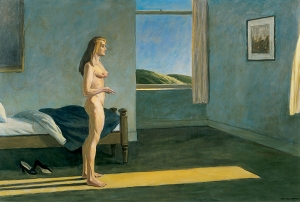
On December 22, American Legends: From Calder to O’Keeffe opened at the Whitney Museum of American Art in New York. The exhibition features works by defining artists of the first half of the twentieth century including Charles Burchfield (1893-1967), Alexander Calder (1898-1976), Stuart Davis (1892-1964), Arthur Dove (1880-1946), Marsden Hartley (1877-1943) , Edward Hopper (1882-1967), Georgia O’Keeffe (1887-1986), and Elie Nadelman (1880-1946).
Drawing from the Whitney’s impressive permanent collection, the yearlong show is organized into small-scale retrospectives for each artist and includes iconic and lesser-known works across a range of mediums. While, many of the works have not been on view in years, the show also includes some of the Whitney’s best-known holdings including Edward Hopper’s A Woman in the Sun (1961), Jacob Lawrence’s War Series 1946), and Georgia O’Keeffe’s Summer Days (1936).
Curated by Barbara Haskell, the exhibition will undergo a rotation in May 2013 so that other artists’ works can be installed. Including realist and modernist masterpieces, American Legends illustrates the dynamic and varied nature of American art during the early twentieth century.
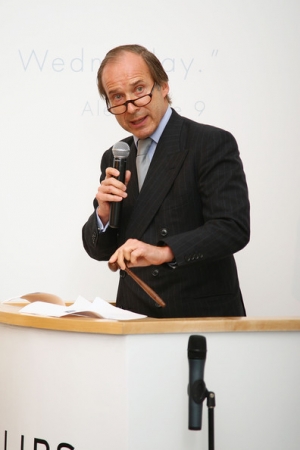
On December 23, Swiss auctioneer and art collector, Simon de Pury, stepped down as Chairman of the New York-based auction house, Phillips de Pury & Company. The announcement was a shock to many as de Pury has helmed the business for the past twelve years. The Russian firm, Mercury Group, recently completed the acquisition of de Pury’s remaining shares in the company.
Phillips’ CEO, Michael McGinnis, said, “Simon has served as a tireless ambassador for the Company and a compelling presence at the podium. We thank him for his spirited enthusiasm, leadership and dedication.”
Beginning in the New Year, the auction house will revert to its original name, Phillips, from its founding in 1796. The company, which specializes in contemporary art and design, has operated under the name Phillips de Pury and Company for the past eight years. In addition, starting in February 2013, the auction house will begin the expansion of its Manhattan headquarters on Park Avenue, adding more gallery and office space.

A house built in 1952 by Frank Lloyd Wright for his son, David, has spent months on the brink of demolition. Fortunately, an anonymous buyer has purchased the Phoenix, Arizona home, ensuring its preservation.
The buyer paid $2.387 million for the house, which overlooks the picturesque Camelback Mountains. The former owners, Steve Sells and John Hoffman of the Arizona-based development company, 8081 Meridian, continued to raise the price of the house after purchasing the property for $1.8 million this past June.
The Frank Lloyd Wright Building Conservancy, an organization devoted to preserving the seminal architect’s legacy, facilitated the recent sale. After hearing that the former owners planned to level the house and split the lot to build new homes, the conservancy petitioned the city with the help of other organizations, asking that the house be granted landmark status. While three local government bodies approved the proposal, the City Council, which would be the deciding vote, repeatedly postponed their decision.
One of Wright’s most significant later works, the house in Phoenix features a coiled design similar to the one Wright employed for the Guggenheim Museum in New York. For years ago, Wright’s granddaughters decided to sell the house to a buyer they thought would preserve it. However, the house was sold again in June to 8081 Meridian putting it in danger of demolition.
While the house is in need of approximately $300,000 worth of restoration, the conservancy is helping to establish a nonprofit organization that will maintain and operate the house as well as oversee the renovation. The new owner plans to acquire landmark status for the house so that it can be made available for educational purposes on a limited basis.
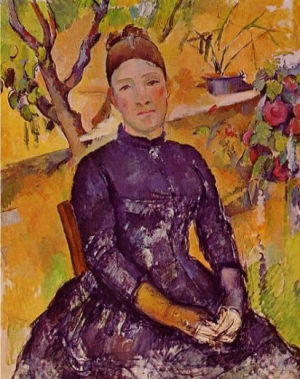
In December 2010, Pierre Konowaloff, the heir to Russian art collector Ivan Morozov, filed a lawsuit claiming that he was the rightful owner of Paul Cézanne’s (1839-1906) painting Madame Cézanne in the Conservatory (1891), not the Metropolitan Museum of Art. Konowaloff explained that Morozov’s art collection was seized by the Bolshevik regime in 1918 and that when Stephen Clark, the collector and museum trustee who bequeathed the work to the Met in 1960, first bought the painting from Knoedler & Company in 1933, he did not carry out due diligence. Accusing the Met of wrongful acquisition, possession, display and retention, Konowaloff demanded that the work be returned to him and requested restitution for monetary damages.
On December 18, a judge in the 2nd District Court of Appeals in Manhattan ruled that the Met could keep the Cézanne masterpiece, as the museum remains the work’s rightful owner. The Met has stood behind their right to the painting since the beginning of the entanglement with Konowaloff. The lawsuit was initially dismissed in 2011 by judge Shira Scheindlin who said that a U.S. court has no basis for questioning a decision made by a foreign government on distant soil. After the rejection of Konowaloff’s appeal, Met officials can finally leave the dispute behind them.
Konowaloff filed a similar suit against Yale University in 2009 over Vincent van Gogh’s (1853-1890) The Night Café (1888). Konowaloff claimed that the van Gogh painting was also stolen during the Russian Revolution and bought by Clark regardless of its questionable history.

For the first time since announcing plans to renovate ten months ago, the New York Public Library has released a number of important project details. Located in a landmark building on Fifth Avenue in Manhattan, the New York Public Library’s $300 million renovation will be overseen by the London-based firm, Foster & Partners.
Architect Norman Foster announced plans to clear out the back portion of the library, which is now occupied by seven floors of books. The 1.2 million ousted volumes will be relocated to a storage space under Bryant Park as well as another facility in Princeton, New Jersey. Most of the exiled books are now available digitally and library officials purposely chose rarely requested books to be relocated. With the newly freed up space, Foster plans to create a four-level atrium with curving balconies filled with bookshelves and reading tables overlooking Bryant Park. It will be the first time since the library was built in 1911 that patrons will be able to see the park.
The library received a fair amount of criticism after announcing plans to renovate. Critics claimed that officials were not forthcoming enough with project details and that the relocation of books stood in stark contrast to the institution’s purpose. In response, Foster revised plans and 3.3 million of the library’s 4.5 million volumes will remain on site.
The busiest public research library in the United States, the New York Public Library will span 100,000 square feet after renovations are complete. Construction is slated to begin this summer and is expected to last until 2018.

Mary Griggs Burke, who built the most comprehensive collection of Japanese art outside of Japan, passed away on December 8, 2012 at her home in Manhattan. She was 96.
Burke’s collection, which she amassed over fifty years, featured thousands of artifacts including paintings, prints, sculpture, textiles, lacquerware, ceramics, and calligraphy. Worth tens of millions of dollars, her meticulously assembled collection spans five millenniums and includes early pieces from around 3000 B.C. to works of the 19th century A.D.
Burke was born in St. Paul, Minnesota in 1916, where she grew up in a Victorian mansion adorned with 18th century French objets d’art as well as a few important Japanese artifacts. After earning a bachelor’s degree in 1938 from Sarah Lawrence College and a master’s in clinical psychology from Columbia, Burke traveled to Japan in 1954. Japanese-influenced Bauhaus architect, Walter Gropius, who was designing a house for Burke, suggested the visit. Burke immediately fell in love with Japan and its art and returned to the country dozens of times throughout her life.
Burke began avidly collecting Japanese art in 1963. Her holdings eventually grew so vast that they required their own residence. Burke purchased the apartment adjacent to her own on the Upper East Side of Manhattan to house her collection; she also employed a curatorial staff and encouraged students and scholars to visit. In 2006, Burke announced that after her death her collection would be divided between the Metropolitan Museum of Art in New York and the Minneapolis Institute of Art. Burke served on the boards of many institutions, including the Met. At the time of her death she was an emeritus trustee of the museum.
Damien Hirst, contemporary artist and leading member of the Young British Artists movement that made headlines in the 1990s, will no longer be represented by Gagosian Gallery, where he has shown his work on and off for 17 years. The news comes as a bit of a shock as earlier this year Gagosian devoted every one of his 11 galleries to Hirst’s abstract “spot” paintings.
While both art world giants claim that the split was amicable, Hirst will continue his association with London’s contemporary White Cube Gallery. It is unclear whether or not Hirst will look for additional representation in another city such as New York, where he has a large collector base.
Hirst, who is known for his excessive works of art that often include dead animals suspended in large tanks of formaldehyde and skulls engulfed in diamonds, has been regarded as the world’s wealthiest artist.
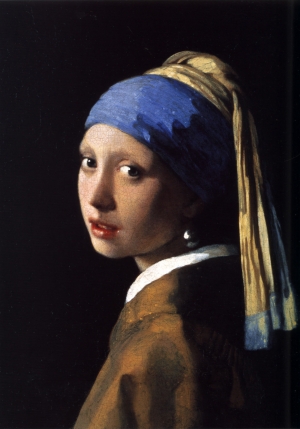
Considered one of Dutch painter Johannes Vermeer’s (1632-1675) masterworks, Girl With a Pearl Earring has spent over a century at the Royal Picture Gallery Mauritshuis in The Hague. Sometimes referred to as the “Dutch Mona Lisa,” the painting, which is not dated, features a wide-eyed young girl whose gaze has been captivating audiences for hundreds of years.
Girl With a Pearl Earring is one of 15 paintings heading to the Frick Collection in New York from the Netherlands. Vermeer, Rembrandt and Hals: Masterpieces of Dutch Painting From the Mauritshuis opens on October 22, 2013 and runs through January 19, 2014. Because of the high level of interest in the enigmatic work, chief curator at the Frick, Colin Bailey, decided to give Girl With a Pearl Earring its own space in the museum’s Oval Room. The rest of the exhibition will be on display in the Frick’s East Gallery.
The Mauritshuis is currently undergoing renovations, which is why part of its collection has been sent out for exhibition. In addition to the Frick, the works will appear in Japan (through January 6, 2013), San Francisco’s de Young Museum (January 26, 2013-June 2, 2013), and Atlanta’s High Museum of Art (June 22, 2013-September 29, 2013). The rest of the Mauritshuis’ collection will remain in the Netherlands and will be exhibited at The Hague’s Gemeentemuseum until the renovations are completed.
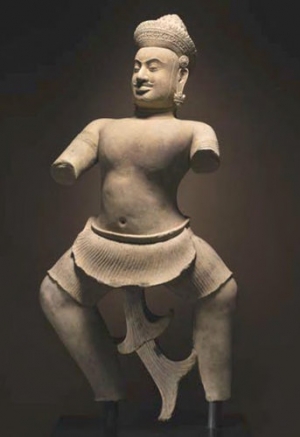
British art collector, Douglas A.J. Latchford, has spent decades building his reputation as one of the foremost experts in Khmer antiquities. Latchford, a resident of Thailand, was knighted in 2008 by the Cambodian government for admirably returning 14th-century Khmer artifacts.
In sharp contrast to his previous accolades, Latchford is currently the subject of a civil complaint files by the U.S. attorney’s office. Federal lawyers state that Latchford, referred to in proceedings as “the Collector,” bought a 10th century Khmer warrior statue known as the Duryodhana in the 1970s knowing that it had been looted from a temple during the Cambodian civil war.
While Latchford denies ever having owned the work, court papers claim that he purchased the statue from a Thai dealer who acquired the work from an organized looting network. Allegedly, Latchford then helped get the piece into Britain by concealing what was actually being shipped. Upon its arrival to the U.K., the auction house Spink & Son sold the statue to a Belgian collector in 1975. The collector’s widow is the Duryodhana’s current owner.
The widow approached Sotheby’s New York in 2010, hoping to sell the 500-pound sandstone statue. However, the sale was put on hold because of objections from the Cambodian government. While lawyers are hoping to return the work to Cambodia, the auction house still plans on selling the treasure, stating that there is no evidence to prove that the statue was looted or that it is the property of the Cambodian government.
Latchford has been collecting Cambodian antiquities for over 55 years and has donated many works to well-known institutions, including the National Museum in Phnom Penh and the Metropolitan Museum of Art. A judge is expected to rule on the Duryodhana case within the next few months.
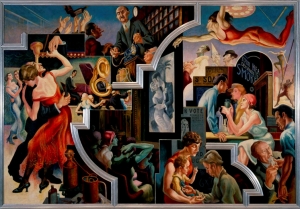
Thomas Hart Benton’s (1889-1975) epic mural, America Today (1930-31) has found a new home at New York’s Metropolitan Museum of Art. A sweeping panorama of American life, the work once lined a boardroom at the International-Style New School for Social Research on West 12th Street, which was designed by the Austrian architect, Joseph Urban (1872-1933).
The 10-panel mural, which was Benton’s first major commission, ushered in a new approach to mural painting, turning to the reality of everyday life for inspiration. America Today portrays American life prior to the Great Depression and features the flappers, farmers, steel workers, and stock market moguls that are readily associated with the period. The mural remains Benton’s best-known work and a masterpiece of modern art.
Benton, an American realist painter, drew inspiration for the mural from his travels around the United States in the 1920s. A glimpse into both rural and urban life at the time, America Today portrays the wealthy and poor as well as the progressive and traditional ideals that defined the era. While Benton did not receive a fee for the commission, the work opened the door for future commissions and helped inspire the Works Progress Administration mural programs that were implemented in the late 1930s.
Bought by the insurance company, AXA Equitable, nearly 30 years ago, America Today was in storage before the decision to donate the work was made. However, the Met is currently without extra exhibition space and the mural won’t be on view until at least 2015 when the museum takes over the Whitney Museum of American Art’s Marcel Breuer building on Madison Avenue. The Whitney is headed to its own larger space in the meatpacking district. America Today is the first artwork that Met officials have confirmed for the Breuer building.
|
|
|
|
|